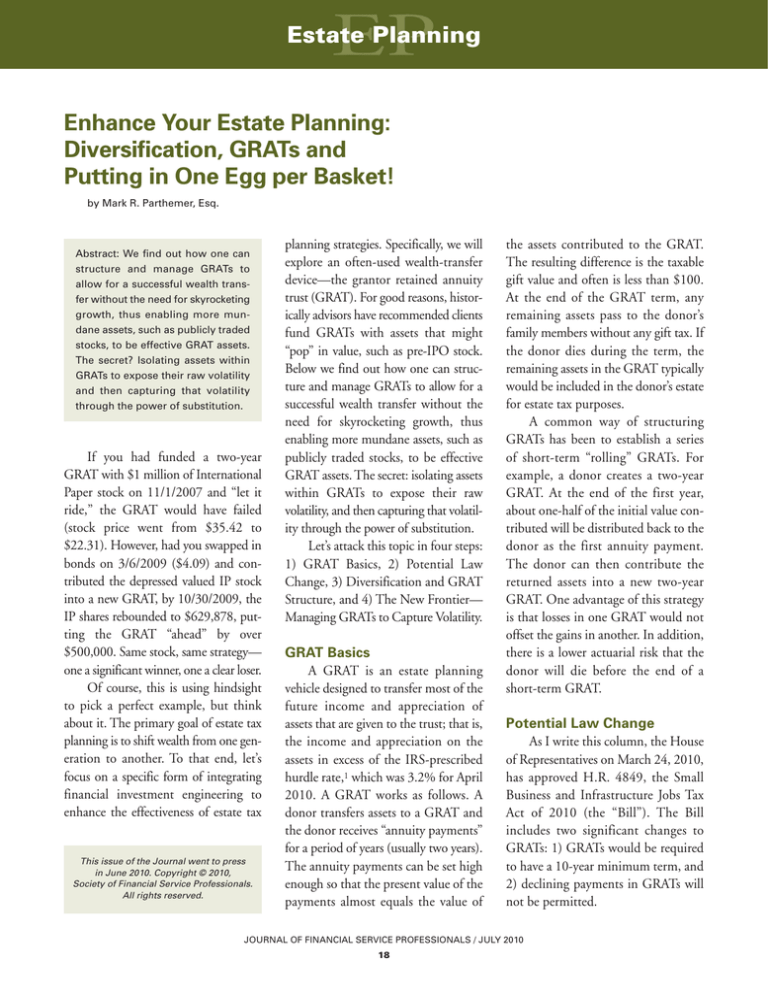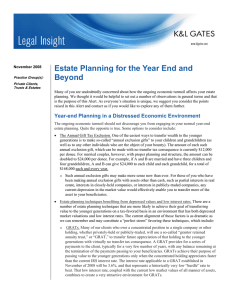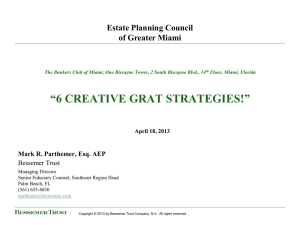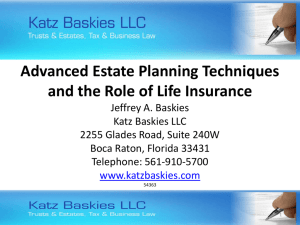
EP
Estate Planning
Enhance Your Estate Planning:
Diversification, GRATs and
Putting in One Egg per Basket!
by Mark R. Parthemer, Esq.
Abstract: We find out how one can
structure and manage GRATs to
allow for a successful wealth transfer without the need for skyrocketing
growth, thus enabling more mundane assets, such as publicly traded
stocks, to be effective GRAT assets.
The secret? Isolating assets within
GRATs to expose their raw volatility
and then capturing that volatility
through the power of substitution.
If you had funded a two-year
GRAT with $1 million of International
Paper stock on 11/1/2007 and “let it
ride,” the GRAT would have failed
(stock price went from $35.42 to
$22.31). However, had you swapped in
bonds on 3/6/2009 ($4.09) and contributed the depressed valued IP stock
into a new GRAT, by 10/30/2009, the
IP shares rebounded to $629,878, putting the GRAT “ahead” by over
$500,000. Same stock, same strategy—
one a significant winner, one a clear loser.
Of course, this is using hindsight
to pick a perfect example, but think
about it. The primary goal of estate tax
planning is to shift wealth from one generation to another. To that end, let’s
focus on a specific form of integrating
financial investment engineering to
enhance the effectiveness of estate tax
This issue of the Journal went to press
in June 2010. Copyright © 2010,
Society of Financial Service Professionals.
All rights reserved.
planning strategies. Specifically, we will
explore an often-used wealth-transfer
device—the grantor retained annuity
trust (GRAT). For good reasons, historically advisors have recommended clients
fund GRATs with assets that might
“pop” in value, such as pre-IPO stock.
Below we find out how one can structure and manage GRATs to allow for a
successful wealth transfer without the
need for skyrocketing growth, thus
enabling more mundane assets, such as
publicly traded stocks, to be effective
GRAT assets. The secret: isolating assets
within GRATs to expose their raw
volatility, and then capturing that volatility through the power of substitution.
Let’s attack this topic in four steps:
1) GRAT Basics, 2) Potential Law
Change, 3) Diversification and GRAT
Structure, and 4) The New Frontier—
Managing GRATs to Capture Volatility.
GRAT Basics
A GRAT is an estate planning
vehicle designed to transfer most of the
future income and appreciation of
assets that are given to the trust; that is,
the income and appreciation on the
assets in excess of the IRS-prescribed
hurdle rate,1 which was 3.2% for April
2010. A GRAT works as follows. A
donor transfers assets to a GRAT and
the donor receives “annuity payments”
for a period of years (usually two years).
The annuity payments can be set high
enough so that the present value of the
payments almost equals the value of
the assets contributed to the GRAT.
The resulting difference is the taxable
gift value and often is less than $100.
At the end of the GRAT term, any
remaining assets pass to the donor’s
family members without any gift tax. If
the donor dies during the term, the
remaining assets in the GRAT typically
would be included in the donor’s estate
for estate tax purposes.
A common way of structuring
GRATs has been to establish a series
of short-term “rolling” GRATs. For
example, a donor creates a two-year
GRAT. At the end of the first year,
about one-half of the initial value contributed will be distributed back to the
donor as the first annuity payment.
The donor can then contribute the
returned assets into a new two-year
GRAT. One advantage of this strategy
is that losses in one GRAT would not
offset the gains in another. In addition,
there is a lower actuarial risk that the
donor will die before the end of a
short-term GRAT.
Potential Law Change
As I write this column, the House
of Representatives on March 24, 2010,
has approved H.R. 4849, the Small
Business and Infrastructure Jobs Tax
Act of 2010 (the “Bill”). The Bill
includes two significant changes to
GRATs: 1) GRATs would be required
to have a 10-year minimum term, and
2) declining payments in GRATs will
not be permitted.
JOURNAL OF FINANCIAL SERVICE PROFESSIONALS / JULY 2010
18
ESTATE PLANNING
By requiring a 10-year minimum
term, the Bill would change the common two-year rolling GRAT approach.
It is likely that fewer GRATs will be
implemented because of the obviously
increased risk of the grantor dying during the term and because donors may
be more cautious about assets being
“tied up” in the GRAT for a much
longer period of time. Finally, the prohibition on declining payments forecloses an idea discussed by some commentators: to provide steeply declining
annuity payments during the 10-year
term so as to effectively make a 10-year
GRAT “act” like a short-term GRAT by
emptying it out in the early years.
No one can predict exactly when
or if the Bill will become law. However,
if the Bill becomes law in its current
form, these changes would become
effective for any GRAT created after
the date of the enactment. Thus,
clients may have only a limited window of time during which to create a
GRAT using the existing rules.
Diversification and
GRAT Structure
Manage Risk, Not Return
The adage: “Don’t put all of your
eggs in one basket!” captures the wisdom that concentrated investments
unnecessarily expose investors to risk.
Risk to an investor is a reflection of
the expansiveness of the band within
which the trading value of an asset fluctuates—the wider the spread between
the potential highs and lows, the
greater the risk of selling at a low price.
Such risk is referred to as “volatility.”
Risk is not a statistical abstraction.
Unfortunately, investors and planners
often focus solely on measuring return.
Return is a consequence over which
the investor has little or no control;
what the investor can manage is risk.
Think of it this way: Would you rather
your 401(k) have a 10% chance of a
50% loss in value, or a 50% chance of
a 10% loss? Let’s highlight this point
another way. Suppose you were an
attorney with a passion to teach, and
you determined you would leave the
practice of law and teach full time as
soon as your investment account was
worth $1 million. The day your
account hits this prized target, a prodigal billionaire offers you a legitimate
flip of a coin: heads, she will give you
$10 million; tails, you give her your
$1 million. A silly wager on her part,
no doubt. But, your decision will
encompass far more than just the
50/50 odds of your being a winner.
You will intuitively and immediately
grasp the huge volatility of the potential return, i.e., 50% chance of an
entire loss. After all, your long-deferred
passion to teach, now realizable, hangs
in the balance.
One also quickly will recognize the
impact of path dependency. That is,
an investment may achieve a certain
return, but the pathway it takes to get
to that return is critical. Here is
another test: Would you rather invest
in a portfolio that averages 8% or one
that averages 10%? The answer, like
the old riddle of how can one drown in
a body of water that averages only 6
inches in depth, requires pausing to
consider what average means (pun
intended). For investors, average return
ignores that which cannot be ignored,
the volatility of interim performance.
Amazingly, differing returns can generate virtually equivalent value, and equivalent returns can generate vastly disparate
results. Table 1 highlights (1) how an
investment that earns 8% every year
returns the same value as a 10% growth
rate with the volatility of 21%, which
approximates that of the typical stock in
the S&P 500, and (2) how two investments with the same 10% return can
have significantly different ending values.
But Why Is Diversification
Counterproductive for GRATs?
Diversification is both fundamentally prudent and deceptively simple in
concept.2 It is in part achieved by owning a basket chock full of uncorrelated
investments. Doing so dampens volatility by minimizing the spread between
the ups and the downs. The impact of
combining uncorrelated assets is to, on
balance, narrow the band between the
portfolio’s peaks and troughs.
Recall that, in essence, assuming
the grantor survives the term, what
transfers to beneficiaries of nearly
zeroed-out GRATs is investment performance in excess of the 7520 rate.
We know diversification is prudent,
largely because it reduces various forms
of investment risk, including moderat-
TABLE 1
Return &
Volatility
8% , 0%
10%, 21%
10%, 0%
Initial
Investment
$1,000,000
$1,000,000
$1,000,000
Ending Value
10 Years
$2,192,440
$2,192,448
$2,593,742
JOURNAL OF FINANCIAL SERVICE PROFESSIONALS / JULY 2010
19
Ending Value
30 Years
$10,538,610
$10,538,721
$17,494,402
Ending Value
50 Years
$50,656,929
$50,657,826
$117,390,853
ESTATE PLANNING
ing volatility. While this is a positive
benefit to mitigate losses, it likewise
mutes gains of the highest performing
components, thus making diversification anathema to GRATs.
Of course, this inherent tension
does not make diversification wrong
or even bad; analytics prove value in
diversification. However, it doesn’t necessarily follow that each “pot” of your
investments must be an exact microcosm of your entire asset allocation.
Instead, concentrated, correlated, or
sector positions within separate GRATs
increase the likelihood of more wealth
transfer. This can be achieved without
forfeiting the benefit of diversification
by using multiple GRATs, perhaps one
for each stock or asset class.
This example illustrates this point.
Assume it was possible to do a oneyear3 nearly zeroed-out GRAT, with a
4% 7520 rate and two stocks, each
worth $5 million. During the year
Stock A increases 20% to $6 million
from $5 million, and Stock B decreases
20% to $4 million from $5 million.
• Option 1—“Diversified” GRAT:
If Stock A and Stock B are in the
same GRAT, the GRAT will fail
and no wealth transfers. This is
because $10.4 million (funding
value plus the 7520 rate) must be
returned to the grantor at the end of
the year to achieve zeroed-out status. However, the portfolio is worth
only $10 million. Thus, no wealth
transfers and so the GRAT failed.
• Planning Option 2—Separate
GRATs: If Stock A and Stock B
are contributed into separate
GRATs, then $800,000 transfers gift, estate, and income tax
free! This is because GRAT #1
with Stock A shares worth $6 mil-
lion returns $5.2 million to the
grantor, leaving $800,000 to heirs.
GRAT #2 with Stock B fails (all is
returned to the grantor). Yet, by
having separate GRATs, the deficit
in GRAT #2 does not diminish
the positive performance in GRAT
#1. Further, there is no downside
tax risk with nearly zeroed-out
GRATs. If the assets underperform
the 7520 rate, they return to
grantor without tax penalty.
Almost every investor recognizes
the inherent benefit of diversification.
The lesson here is that for GRATs and
other estate tax planning strategies, each
technique can be funded with a concentrated part of the overall diversified
portfolio. The result is to maintain the
protection of diversification on the
entire investment allocation, yet take
advantage to the upside potential of
concentration. In other words, by isolating the components of a diversified
portfolio and funding segments into
separate GRATs, each separate GRAT
will have a higher alpha that will not be
offset by the other segments.
So, it remains prudent for investors
to avoid putting all of their eggs in one
basket. When funding GRATs, however, more wealth likely will transfer tax
free to children or other beneficiaries
by placing the investment “eggs” into
separate GRAT “baskets.”
The New Frontier—Managing
GRATs to Capture Volatility!
“Now this is not the end. It is not
even the beginning of the end. But it is,
perhaps, the end of the beginning.”
—Winston Churchill
Now that this structural concept
has been embraced and mastered, it
opens the door to more sophisticated
management of GRATs. As we all
know, GRATs permit income-tax free
substitution of assets by the grantor,
so long as they are of equivalent value.
An exciting and powerful next step
is to take further advantage of the
volatility of the now “separate asset
GRATs” by capturing interim swings
in asset values. An approach I support
is to set a range when funding a GRAT.
The range is typically one standard
deviation of an asset’s expected volatility. Next, vigilantly monitor the GRAT
assets.4 Any time the asset’s value is
outside one standard deviation, consider substitution to “lock in” gains or
“get a fresh start” off a downturn.
For example, assume the expected
range of value on a $5 million position is between $4.2 million and $5.8
million, but during the GRAT term
(say within 6 months of funding), the
stock shoots to $6 million. It might be
wise to swap out the stock to “lock-in”
the $1 million gain (and re-GRAT if
there is belief that the stock has more
room to move up). By doing so, the $1
million of growth can be protected
against potential decline or reversion
to the mean. In addition, re-GRATing
the stock will be almost seamless unless
the 7520 rate has changed dramatically
(or there has been a law change). So,
the gain from the interim outsized
return can be “taken off the table”
without hampering future additional
success and without exposing the
GRAT to any “give back.”
With one client, for example, we
funded some GRATs in 2008. Over the
next two years, the markets went down
(radically), and came roaring back. Had
we simply left the GRATs alone, they
would have failed. However, by fortuitous substitutions throughout, each
JOURNAL OF FINANCIAL SERVICE PROFESSIONALS / JULY 2010
20
ESTATE PLANNING
GRAT transferred almost 50% of the
original funding value.
The fun doesn’t stop with substitution, of course, as there is value to
tailoring the investment orientation of
the substituted assets given their role
and the type of trust in which they are
held. It can be as simple as when a
stock has outperformed expectation,
substituting for it with bonds or a
fixed-income portfolio. The gain
should be protected through management of the swapped-in bonds. Further, often clients are holding municipal bonds. While the number one goal
will be to preserve value, since the
GRAT is a grantor trust for income tax
purposes, one next can determine
whether the yield be enhanced by
introducing, say, taxable bonds, with-
out increasing volatility.
The opportunity is that the client’s
entire team of wealth advisors—the
attorney, CPA, insurance and financial
advisor—together can take a wonderful
strategy and make it even more effective to the ultimate goal of any such
planning—efficient transfer of wealth
from one generation to another. ■
Mark R. Parthemer, Esq., is Managing
Director and Fiduciary Counsel, Southeast Region, overseeing estate and legacy
planning services at Bessemer Trust, an
exclusive wealth management firm. He
is a frequent national lecturer and published author; Vice Chair, ABA Insurance
& Financial Planning Committee; member, Florida and Pennsylvania Bars, and
the Florida Bankers Association Executive Council, and chair, Trust Legislation
Committee. He has been part of the University of Miami’s Heckerling faculty and
is a former adjunct professor, Widener
University School of Law. Mark often has
been recognized as one of the Best
Lawyers in America and a Florida Legal
Eagle. He may be reached at parthemer@bessemer.com.
(1) The 7520 rate, which is 120% of the midterm
AFR, rounded to the nearest two tenths of 1%.
(2) Many very smart, highly educated professionals will no doubt cringe at this oversimplification; divining correlations to construct a
portfolio is sophisticated work.
(3) Even under the current law, GRATs must be
for a term of more than one year.
(4) This GRAT program results in many
GRATs, so my firm has designed a proprietary
software program to monitor asset values. It
sends an e-mail alert when a stock’s price is outside the determined range.
JOURNAL OF FINANCIAL SERVICE PROFESSIONALS / JULY 2010
21








